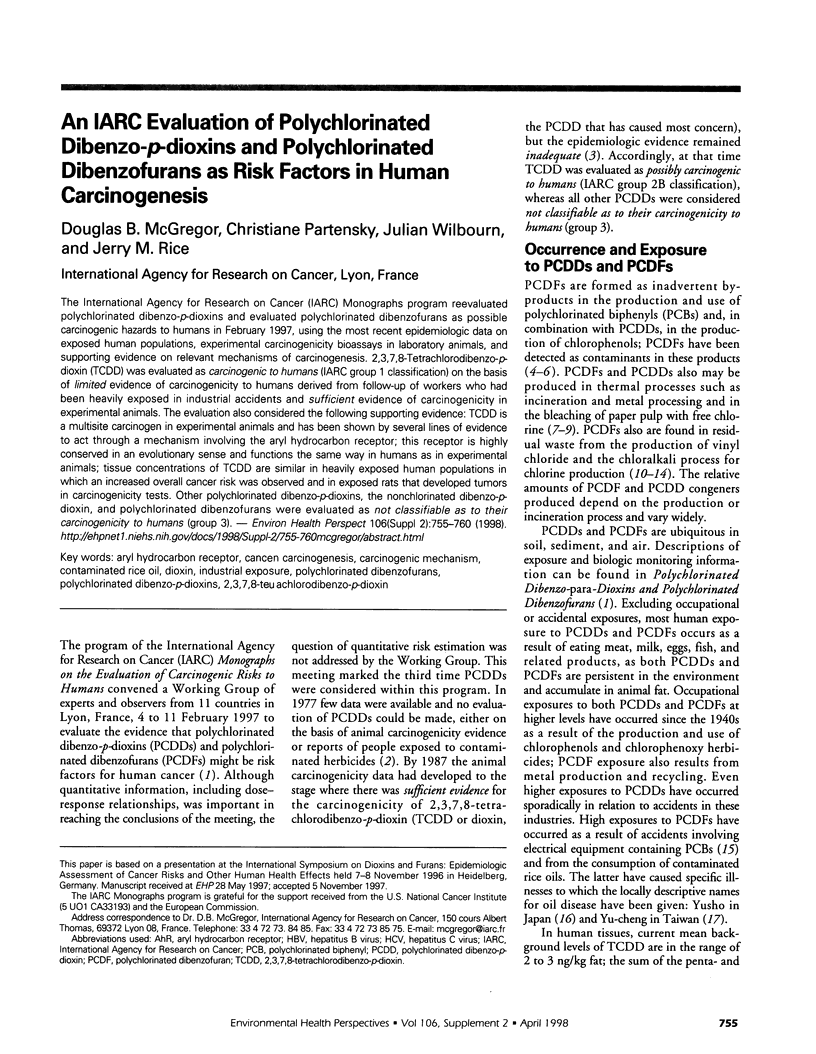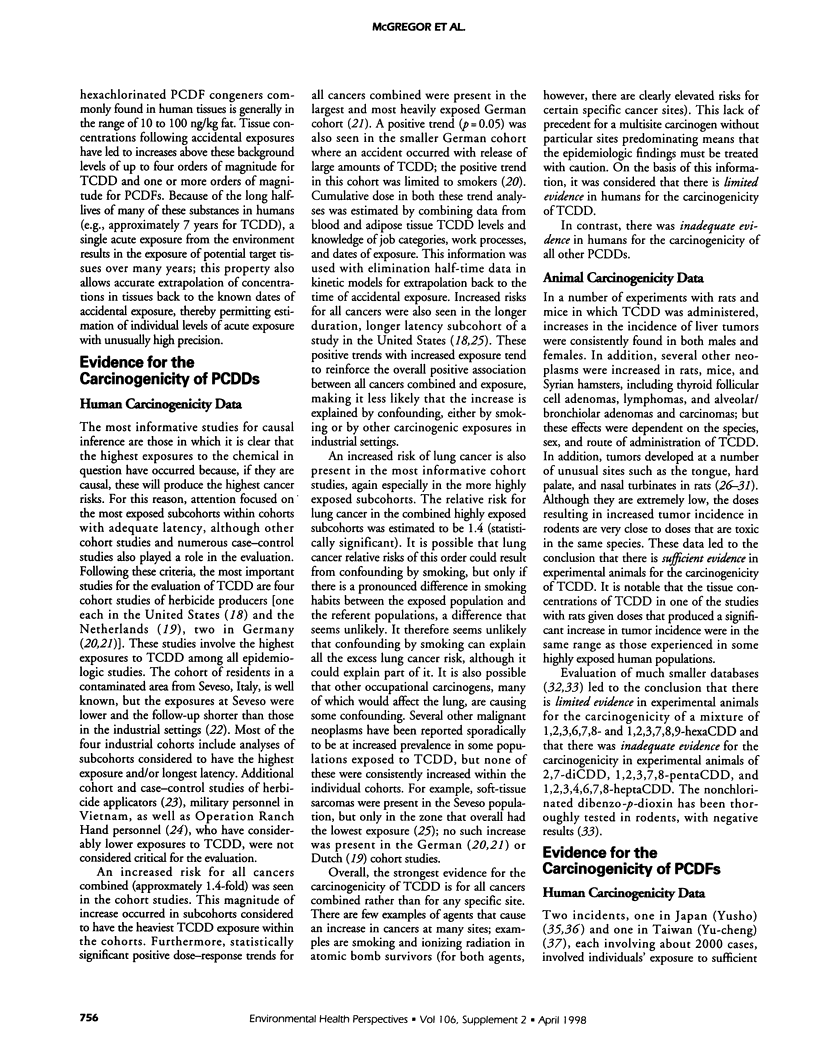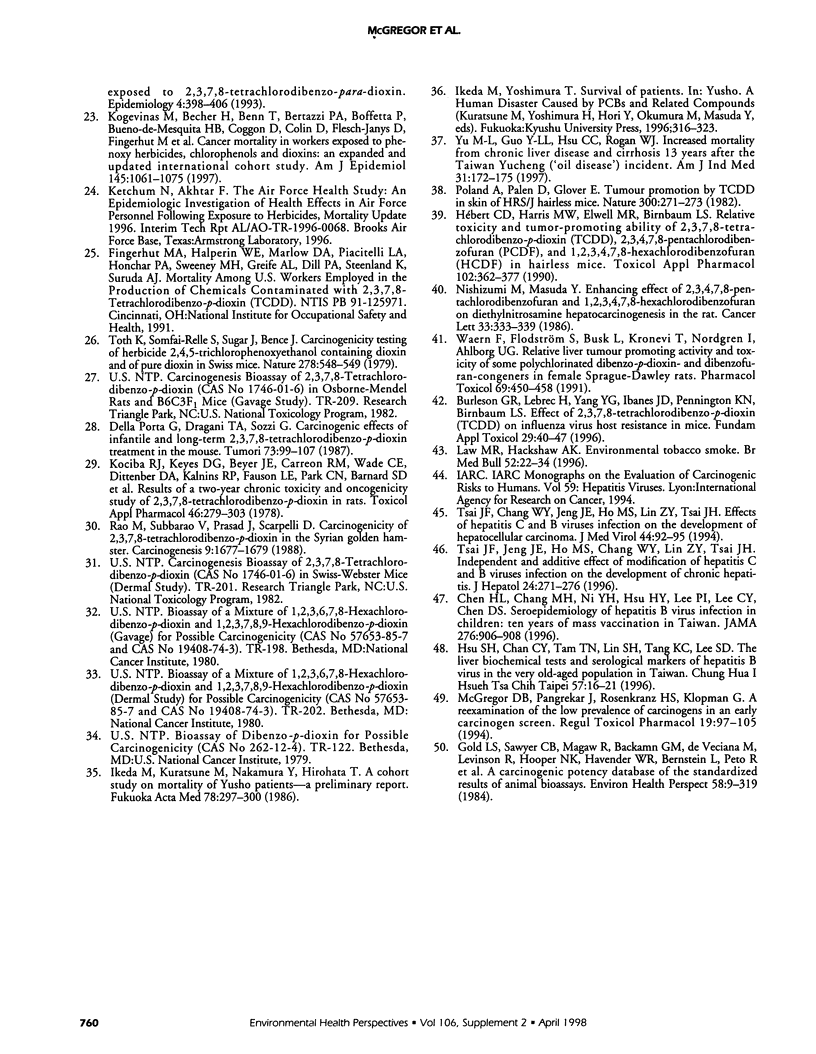Abstract
The International Agency for Research on Cancer (IARC) Monographs program reevaluated polychlorinated dibenzo-p-dioxins and evaluated polychlorinated dibenzofurans as possible carcinogenic hazards to humans in February 1997, using the most recent epidemiologic data on exposed human populations, experimental carcinogenicity bioassays in laboratory animals, and supporting evidence on relevant mechanisms of carcinogenesis. 2,3,7,8-Tetrachlorodibenzo-p-dioxin (TCDD) was evaluated as carcinogenic to humans (IARC group 1 classification) on the basis of limited evidence of carcinogenicity to humans derived from follow-up of workers who had been heavily exposed in industrial accidents and sufficient evidence of carcinogenicity in experimental animals. The evaluation also considered the following supporting evidence: TCDD is a multisite carcinogen in experimental animals and has been shown by several lines of evidence to act through a mechanism involving the aryl hydrocarbon receptor; this receptor is highly conserved in an evolutionary sense and functions the same way in humans as in experimental animals; tissue concentrations of TCDD are similar in heavily exposed human populations in which an increased overall cancer risk was observed and in exposed rats that developed tumors in carcinogenicity tests. Other polychlorinated dibenzo-p-dioxins, the nonchlorinated dibenzo-p-dioxin, and polychlorinated dibenzofurans were evaluated as not classifiable as to their carcinogenicity to humans (group 3).
Full text
PDF





Selected References
These references are in PubMed. This may not be the complete list of references from this article.
- Burleson G. R., Lebrec H., Yang Y. G., Ibanes J. D., Pennington K. N., Birnbaum L. S. Effect of 2,3,7,8-tetrachlorodibenzo-p-dioxin (TCDD) on influenza virus host resistance in mice. Fundam Appl Toxicol. 1996 Jan;29(1):40–47. doi: 10.1006/faat.1996.0004. [DOI] [PubMed] [Google Scholar]
- Chen H. L., Chang M. H., Ni Y. H., Hsu H. Y., Lee P. I., Lee C. Y., Chen D. S. Seroepidemiology of hepatitis B virus infection in children: Ten years of mass vaccination in Taiwan. JAMA. 1996 Sep 18;276(11):906–908. [PubMed] [Google Scholar]
- Della Porta G., Dragani T. A., Sozzi G. Carcinogenic effects of infantile and long-term 2,3,7,8-tetrachlorodibenzo-p-dioxin treatment in the mouse. Tumori. 1987 Apr 30;73(2):99–107. doi: 10.1177/030089168707300203. [DOI] [PubMed] [Google Scholar]
- Fingerhut M. A., Halperin W. E., Marlow D. A., Piacitelli L. A., Honchar P. A., Sweeney M. H., Greife A. L., Dill P. A., Steenland K., Suruda A. J. Cancer mortality in workers exposed to 2,3,7,8-tetrachlorodibenzo-p-dioxin. N Engl J Med. 1991 Jan 24;324(4):212–218. doi: 10.1056/NEJM199101243240402. [DOI] [PubMed] [Google Scholar]
- Flesch-Janys D., Berger J., Gurn P., Manz A., Nagel S., Waltsgott H., Dwyer J. H. Exposure to polychlorinated dioxins and furans (PCDD/F) and mortality in a cohort of workers from a herbicide-producing plant in Hamburg, Federal Republic of Germany. Am J Epidemiol. 1995 Dec 1;142(11):1165–1175. doi: 10.1093/oxfordjournals.aje.a117575. [DOI] [PubMed] [Google Scholar]
- Gold L. S., Sawyer C. B., Magaw R., Backman G. M., de Veciana M., Levinson R., Hooper N. K., Havender W. R., Bernstein L., Peto R. A carcinogenic potency database of the standardized results of animal bioassays. Environ Health Perspect. 1984 Dec;58:9–319. doi: 10.1289/ehp.84589. [DOI] [PMC free article] [PubMed] [Google Scholar]
- Hansson M., Barregård L., Sällsten G., Svensson B. G., Rappe C. Polychlorinated dibenzo-p-dioxin and dibenzofuran levels and patterns in polyvinylchloride and chloralkali industry workers. Int Arch Occup Environ Health. 1997;70(1):51–56. doi: 10.1007/s004200050185. [DOI] [PubMed] [Google Scholar]
- Hsu S. H., Chan C. Y., Tam T. N., Lin S. H., Tang K. C., Lee S. D. The liver biochemical tests and serological markers of hepatitis B virus in the very old-aged population in Taiwan. Zhonghua Yi Xue Za Zhi (Taipei) 1996 Jan;57(1):16–21. [PubMed] [Google Scholar]
- Hsu S. T., Ma C. I., Hsu S. K., Wu S. S., Hsu N. H., Yeh C. C., Wu S. B. Discovery and epidemiology of PCB poisoning in Taiwan: a four-year followup. Environ Health Perspect. 1985 Feb;59:5–10. doi: 10.1289/ehp.59-1568088. [DOI] [PMC free article] [PubMed] [Google Scholar]
- Hébert C. D., Harris M. W., Elwell M. R., Birnbaum L. S. Relative toxicity and tumor-promoting ability of 2,3,7,8-tetrachlorodibenzo-p-dioxin (TCDD), 2,3,4,7,8-pentachlorodibenzofuran (PCDF), and 1,2,3,4,7,8-hexachlorodibenzofuran (HCDF) in hairless mice. Toxicol Appl Pharmacol. 1990 Feb;102(2):362–377. doi: 10.1016/0041-008x(90)90033-q. [DOI] [PubMed] [Google Scholar]
- Ikeda M., Kuratsune M., Nakamura Y., Hirohata T. A cohort study on mortality of yusho patients--a preliminary report. Fukuoka Igaku Zasshi. 1987 May;78(5):297–300. [PubMed] [Google Scholar]
- Kociba R. J., Keyes D. G., Beyer J. E., Carreon R. M., Wade C. E., Dittenber D. A., Kalnins R. P., Frauson L. E., Park C. N., Barnard S. D. Results of a two-year chronic toxicity and oncogenicity study of 2,3,7,8-tetrachlorodibenzo-p-dioxin in rats. Toxicol Appl Pharmacol. 1978 Nov;46(2):279–303. doi: 10.1016/0041-008x(78)90075-3. [DOI] [PubMed] [Google Scholar]
- Kogevinas M., Becher H., Benn T., Bertazzi P. A., Boffetta P., Bueno-de-Mesquita H. B., Coggon D., Colin D., Flesch-Janys D., Fingerhut M. Cancer mortality in workers exposed to phenoxy herbicides, chlorophenols, and dioxins. An expanded and updated international cohort study. Am J Epidemiol. 1997 Jun 15;145(12):1061–1075. doi: 10.1093/oxfordjournals.aje.a009069. [DOI] [PubMed] [Google Scholar]
- Kuratsune M., Yoshimura T., Matsuzaka J., Yamaguchi A. Epidemiologic study on Yusho, a Poisoning Caused by Ingestion of Rice Oil Contaminated with a Commercial Brand of Polychlorinated Biphenyls. Environ Health Perspect. 1972 Apr;1:119–128. doi: 10.1289/ehp.7201119. [DOI] [PMC free article] [PubMed] [Google Scholar]
- Law M. R., Hackshaw A. K. Environmental tobacco smoke. Br Med Bull. 1996 Jan;52(1):22–34. doi: 10.1093/oxfordjournals.bmb.a011528. [DOI] [PubMed] [Google Scholar]
- McGregor D. B., Pangrekar J., Rosenkranz H. S., Klopman G. A reexamination of the low prevalence of carcinogens in an early carcinogen screen. Regul Toxicol Pharmacol. 1994 Feb;19(1):97–105. doi: 10.1006/rtph.1994.1008. [DOI] [PubMed] [Google Scholar]
- Nishizumi M., Masuda Y. Enhancing effect of 2,3,4,7,8-pentachlorodibenzofuran and 1,2,3,4,7,8-hexachlorodibenzofuran on diethylnitrosamine hepatocarcinogenesis in rats. Cancer Lett. 1986 Dec;33(3):333–339. doi: 10.1016/0304-3835(86)90073-x. [DOI] [PubMed] [Google Scholar]
- Ott M. G., Zober A. Cause specific mortality and cancer incidence among employees exposed to 2,3,7,8-TCDD after a 1953 reactor accident. Occup Environ Med. 1996 Sep;53(9):606–612. doi: 10.1136/oem.53.9.606. [DOI] [PMC free article] [PubMed] [Google Scholar]
- Poland A., Palen D., Glover E. Tumour promotion by TCDD in skin of HRS/J hairless mice. Nature. 1982 Nov 18;300(5889):271–273. doi: 10.1038/300271a0. [DOI] [PubMed] [Google Scholar]
- Rao M. S., Subbarao V., Prasad J. D., Scarpelli D. G. Carcinogenicity of 2,3,7,8-tetrachlorodibenzo-p-dioxin in the Syrian golden hamster. Carcinogenesis. 1988 Sep;9(9):1677–1679. doi: 10.1093/carcin/9.9.1677. [DOI] [PubMed] [Google Scholar]
- Tsai J. F., Chang W. Y., Jeng J. E., Ho M. S., Lin Z. Y., Tsai J. H. Effects of hepatitis C and B viruses infection on the development of hepatocellular carcinoma. J Med Virol. 1994 Sep;44(1):92–95. doi: 10.1002/jmv.1890440117. [DOI] [PubMed] [Google Scholar]
- Tsai J. F., Jeng J. E., Ho M. S., Chang W. Y., Lin Z. Y., Tsai J. H. Independent and additive effect modification of hepatitis C and B viruses infection on the development of chronic hepatitis. J Hepatol. 1996 Mar;24(3):271–276. doi: 10.1016/s0168-8278(96)80004-3. [DOI] [PubMed] [Google Scholar]
- Tóth K., Somfai-Relle S., Sugár J., Bence J. Carcinogenicity testing of herbicide 2,4,5-trichlorophenoxyethanol containing dioxin and of pure dioxin in Swiss mice. Nature. 1979 Apr 5;278(5704):548–549. doi: 10.1038/278548a0. [DOI] [PubMed] [Google Scholar]
- Vos J. G., Koeman J. H., van der Maas H. L., ten Noever de Brauw M. C., de Vos R. H. Identification and toxicological evaluation of chlorinated dibenzofuran and chlorinated naphthalene in two commercial polychlorinated biphenyls. Food Cosmet Toxicol. 1970 Dec;8(6):625–633. doi: 10.1016/s0015-6264(70)80451-5. [DOI] [PubMed] [Google Scholar]
- Waern F., Flodström S., Busk L., Kronevi T., Nordgren I., Ahlborg U. G. Relative liver tumour promoting activity and toxicity of some polychlorinated dibenzo-p-dioxin- and dibenzofuran-congeners in female Sprague-Dawley rats. Pharmacol Toxicol. 1991 Dec;69(6):450–458. doi: 10.1111/j.1600-0773.1991.tb01328.x. [DOI] [PubMed] [Google Scholar]
- Yu M. L., Guo Y. L., Hsu C. C., Rogan W. J. Increased mortality from chronic liver disease and cirrhosis 13 years after the Taiwan "yucheng" ("oil disease") incident. Am J Ind Med. 1997 Feb;31(2):172–175. doi: 10.1002/(sici)1097-0274(199702)31:2<172::aid-ajim6>3.0.co;2-1. [DOI] [PubMed] [Google Scholar]


